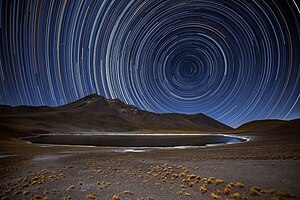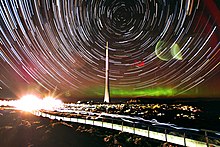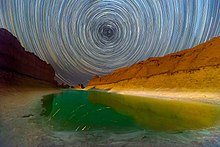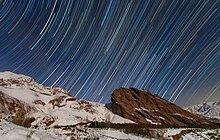Diurnal motion is an astronomical term referring to the apparent motion of celestial objects around Earth, or more precisely around the two celestial poles, over the course of one day. It is caused by Earth's rotation around its axis, so almost every star appears to follow a circular arc path, called the diurnal circle, often depicted in star trail photography.

Astrophotography, also known as astronomical imaging, is the photography or imaging of astronomical objects, celestial events, or areas of the night sky. The first photograph of an astronomical object was taken in 1840, but it was not until the late 19th century that advances in technology allowed for detailed stellar photography. Besides being able to record the details of extended objects such as the Moon, Sun, and planets, modern astrophotography has the ability to image objects outside of the visible spectrum of the human eye such as dim stars, nebulae, and galaxies. This is accomplished through long time exposure as both film and digital cameras can accumulate and sum photons over long periods of time or using specialized optical filters which limit the photons to a certain wavelength.

In photography, shutter speed or exposure time is the length of time that the film or digital sensor inside the camera is exposed to light when taking a photograph. The amount of light that reaches the film or image sensor is proportional to the exposure time. 1⁄500 of a second will let half as much light in as 1⁄250.

In photography, exposure is the amount of light per unit area reaching a frame of photographic film or the surface of an electronic image sensor. It is determined by shutter speed, lens F-number, and scene luminance. Exposure is measured in units of lux-seconds, and can be computed from exposure value (EV) and scene luminance in a specified region.

Motion blur is the apparent streaking of moving objects in a photograph or a sequence of frames, such as a film or animation. It results when the image being recorded changes during the recording of a single exposure, due to rapid movement or long exposure.

Observational astronomy is a division of astronomy that is concerned with recording data about the observable universe, in contrast with theoretical astronomy, which is mainly concerned with calculating the measurable implications of physical models. It is the practice and study of observing celestial objects with the use of telescopes and other astronomical instruments.
The science of photography is the use of chemistry and physics in all aspects of photography. This applies to the camera, its lenses, physical operation of the camera, electronic camera internals, and the process of developing film in order to take and develop pictures properly.

Time-lapse photography is a technique in which the frequency at which film frames are captured is much lower than the frequency used to view the sequence. When played at normal speed, time appears to be moving faster and thus lapsing. For example, an image of a scene may be captured at 1 frame per second but then played back at 30 frames per second; the result is an apparent 30 times speed increase. Similarly, film can also be played at a much lower rate than at which it was captured, which slows down an otherwise fast action, as in slow motion or high-speed photography.

The Bulb setting on camera shutters is a momentary-action mode that holds shutters open for as long as a photographer depresses the shutter-release button. The Bulb setting is distinct from shutter's Time (T) setting, which is an alternate-action mode where the shutter opens when the shutter-release button is pressed and released once, and closes when the button is actuated again.

An astrograph is a telescope designed for the sole purpose of astrophotography. Astrographs are mostly used in wide-field astronomical surveys of the sky and for detection of objects such as asteroids, meteors, and comets.

High-speed photography is the science of taking pictures of very fast phenomena. In 1948, the Society of Motion Picture and Television Engineers (SMPTE) defined high-speed photography as any set of photographs captured by a camera capable of 69 frames per second or greater, and of at least three consecutive frames. High-speed photography can be considered to be the opposite of time-lapse photography.

The ESA/ESO/NASA FITS Liberator is a free software program for processing and editing astronomical science data in the FITS format to reproduce images of the universe. Version 3 and later are standalone programs; earlier versions were plugins for Adobe Photoshop. FITS Liberator is free software released under the BSD-3 license. The engine behind the FITS Liberator is NASA's CFITSIO library.

Night photography refers to the activity of capturing images outdoors at night, between dusk and dawn. Night photographers generally have a choice between using artificial lighting and using a long exposure, exposing the shot for seconds, minutes, or even hours in order to give photosensitive film or an image sensor enough time to capture a desirable image. With the progress of high-speed films, higher-sensitivity digital sensors, wide-aperture lenses, and the ever-greater power of urban lights, night photography is increasingly possible using available light.

In amateur astronomy, "GoTo" refers to a type of telescope mount and related software that can automatically point a telescope at astronomical objects that the user selects. Both axes of a GoTo mount are driven by a motor and controlled by a computer. It may be either a microprocessor-based integrated controller or an external personal computer. This differs from the single-axis semi-automated tracking of a traditional clock-drive equatorial mount.
Zoom burst is a photographic technique, attainable with zoom lenses with a manual zoom ring.

A barn door tracker, also known as a Haig or Scotch mount, is a device used to cancel out the diurnal motion of the Earth for the observation or photography of astronomical objects. It is a simple alternative to attaching a camera to a motorized equatorial mount.
Polar alignment is the act of aligning the rotational axis of a telescope's equatorial mount or a sundial's gnomon with a celestial pole to parallel Earth's axis.

Long-exposure, time-exposure, or slow-shutter photography involves using a long-duration shutter speed to sharply capture the stationary elements of images while blurring, smearing, or obscuring the moving elements. Long-exposure photography captures one element that conventional photography does not: an extended period of time.

Fireworks photography is the process of taking photographs of fireworks at night. It is a type of night photography, specifically using available light of the fireworks instead of artificial light. Without using the flash on the camera, the photographer often exposes the image for a period of time, known as long exposure. Brighter fireworks sometimes support shorter exposure times.


























